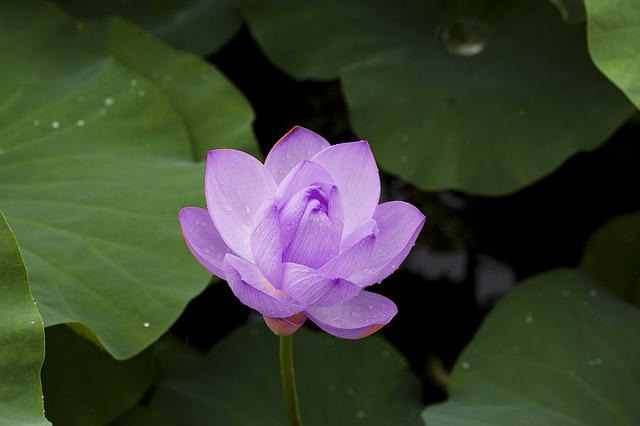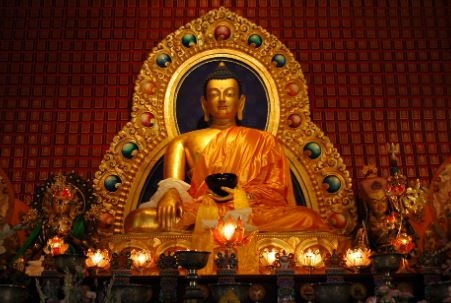The lotus flower holds deep symbolic significance in Buddhism, representing purity, enlightenment, and spiritual perfection. The four main types of lotus flowers in Buddhism—white, red, blue, and purple—each carry unique symbolism, encompassing virtues like purity, compassion, wisdom, and spirituality.
The image of a Buddha’s hand holding a lotus flower carries profound symbolism in Buddhist iconography, representing symbolic gesture is known as the “Padmakosa Mudra,” and it holds rich meanings deeply rooted in Buddhist philosophy.
The lotus flower, a revered symbol in Buddhism, holds immense significance as a representation of purity, enlightenment, and spiritual perfection. Additionally, its symbolic meanings extend into Hinduism, where it embodies various aspects of spiritual and personal growth. This exploration delves into the four main types of lotus flowers in Buddhism, their symbolism, and the broader perspectives in Hinduism.
The Four Types of Lotus in Buddhism
The symbolism of lotus flowers in Buddhism is rich and diverse, with each type carrying its own unique meaning. These four varieties are integral to Buddhist philosophy, embodying virtues and stages of spiritual development.
White Lotus
- Symbolism: Purity and Innocence The white lotus, the most common symbol of Buddhism, represents purity, innocence, and spiritual perfection. The Buddha is often depicted seated on a white lotus flower, signifying his attainment of enlightenment.
- Connection to Enlightenment The white lotus serves as a powerful symbol of the potential for enlightenment within each being. Its ability to emerge from the muddy depths mirrors the journey from ignorance to spiritual awakening.
- Representation in Buddhist Art Artistic depictions often showcase the Buddha seated on a white lotus, emphasizing the transformative power of enlightenment and the purity that can arise from the depths of human experience.

Red Lotus
- Symbolism: Compassion and Love The red lotus symbolizes compassion, love, and passion. It is closely associated with the bodhisattva Avalokiteshvara, who embodies the compassion of all Buddhas.
- Associated with Avalokiteshvara Depictions of Avalokiteshvara often feature the red lotus, highlighting the connection between compassion and the potential for enlightenment.
- Depiction in Buddhist Iconography Art representing Avalokiteshvara with a red lotus serves as a visual reminder of the compassionate nature inherent in the journey toward enlightenment.

Blue Lotus
- Symbolism: Wisdom and Knowledge The blue lotus represents wisdom, knowledge, and spiritual insight. It is associated with the bodhisattva Manjushri, who embodies the wisdom of all Buddhas.
- Connection to Bodhisattva Manjushri The blue lotus signifies the pursuit of wisdom on the path to enlightenment. It is a visual representation of the intellectual and insightful aspects of spiritual growth.
- Artistic Representations and Interpretations In Buddhist art, the blue lotus is often depicted alongside Manjushri, illustrating the integration of wisdom into the journey toward spiritual awakening.

Purple Lotus
- Symbolism: Spirituality, Mysticism, and Transformation The purple lotus represents spirituality, mysticism, and transformation. It is associated with the Buddha himself and symbolizes the highest level of spiritual attainment.
- Association with the Buddha The purple lotus, linked directly to the Buddha, signifies a profound spiritual transformation and the ultimate realization of enlightenment.
- Highest Level of Spiritual Attainment Artistic representations of the purple lotus convey the mysticism and transformative power associated with reaching the pinnacle of spiritual development.

Unity in Symbolism

- Depiction in Buddhist Art Artistic compositions often feature all four types of lotus flowers together, symbolizing the unity of virtues—compassion, wisdom, love, and purity.
- Representing Cardinal Virtues The four lotus types collectively represent the cardinal virtues in Buddhism—compassion, wisdom, love, and purity—an interconnected tapestry of qualities to cultivate on the path to enlightenment.
- Symbolizing Spiritual Development Stages In addition to representing virtues, the four lotus types symbolize the stages of spiritual development: the mud (ignorance), the water (faith), the surface of the water (near enlightenment), and the fully opened flower (enlightenment).
The image of a Buddha’s hand holding a lotus flower carries profound symbolism in Buddhist iconography, representing various aspects of spiritual significance. This symbolic gesture is known as the “Padmakosa Mudra,” and it holds rich meanings deeply rooted in Buddhist philosophy. Here is an exploration of the meaning behind Buddha’s hand holding a lotus flower:
1. Enlightenment and Purity:
The lotus flower, known for its ability to grow immaculately from muddy waters, symbolizes purity rising from the impurities of the world. When held by the hand of the Buddha, it signifies the attainment of enlightenment and spiritual perfection despite the challenges and struggles present in the material world.
2. Compassion and Detachment:
The act of holding the lotus in the Buddha’s hand signifies compassion for all beings. The lotus, untouched by the impurities of its surroundings, reflects the idea of detached compassion, where one can engage with the world without being tainted by its negativity.
3. Non-Attachment and Liberation:
The lotus is often associated with non-attachment and liberation from worldly desires. By holding the lotus, the Buddha teaches the importance of remaining detached from material attachments to achieve a state of inner peace and spiritual liberation.
4. Symbol of the Eightfold Path:
The eight petals of the lotus may symbolize the Noble Eightfold Path, a fundamental guide to ethical and mental development in Buddhism. Each petal corresponds to one of the eight aspects of the path, reinforcing the importance of following this path for spiritual growth.
5. Divine Generosity:
The act of holding the lotus can also represent the Buddha’s divine generosity and the offering of spiritual teachings to humanity. The lotus, often presented as an offering, symbolizes the giving of wisdom, compassion, and enlightenment to others.
6. Pure Consciousness:
The lotus flower is not only a symbol of purity but also of pure consciousness. By holding the lotus, the Buddha signifies the awakened mind and the attainment of a state of pure awareness and understanding.
7. Cycles of Existence:
The lotus has a unique life cycle, from the muddy waters to the surface, where it blooms in pristine beauty. This cycle mirrors the Buddhist concept of samsara, the cycle of birth, death, and rebirth. The Buddha’s hand holding the lotus may symbolize the transcendence of this cycle through enlightenment.
The Eight-Petal Lotus in Buddhism

The eight-petal lotus in Buddhism carries profound symbolism, corresponding to the Noble Eightfold Path—a fundamental guideline for achieving liberation from suffering.
Symbolism of the Eight Petals
- Correspondence to Noble Eightfold Path Each petal of the lotus corresponds to an aspect of the Noble Eightfold Path, providing a visual representation of the fundamental principles for leading a wholesome and enlightened life.
- Noble Eightfold Path Explained The eight aspects, including right understanding, thought, speech, action, livelihood, effort, mindfulness, and concentration, form the foundation for ethical conduct, mental discipline, and wisdom.
- Lotus as a Symbol for Enlightenment Potential The eight-petal lotus serves as a reminder of the path to liberation, emphasizing the importance of ethical conduct, mental discipline, and wisdom in the pursuit of enlightenment.
The Seven-Petal Lotus in Various Cultures

The seven-petal lotus, significant in Hinduism, Buddhism, and Taoism, symbolizes spiritual growth, enlightenment, and the interconnectedness of all things.
Symbolism in Hinduism, Buddhism, and Taoism
- Representation of Chakras In Hinduism, the seven-petal lotus corresponds to the seven chakras, symbolizing the harmonious balance of energy centers leading to spiritual awakening.
- Symbolizing the Dharmas of Enlightenment In Buddhism, the seven-petal lotus represents the seven treasures, embodying the qualities and practices that lead to the ultimate realization of true nature and liberation from suffering.
- Connection with the Big Dipper in Taoism Taoism associates the seven-petal lotus with the seven stars of the Big Dipper, emphasizing longevity, immortality, and the connection between earthly and celestial realms.
General Symbolism
- Spiritual Growth and Transformation The emergence of the lotus from the mud symbolizes the journey of spiritual growth, overcoming obstacles, and blossoming into enlightenment.
- Purity and Transcendence Immaculate petals signify purity of thought, speech, and action—essential qualities for spiritual elevation.
- Cosmic Harmony and Balance The seven petals represent the seven elements of nature, symbolizing the balance and interconnectedness of the universe.
- Divine Manifestation The lotus is often associated with deities, symbolizing the manifestation of divine qualities within oneself.
The seven-petal lotus serves as a powerful symbol of spiritual potential, transformation, and the interconnectedness of all things. It inspires individuals to cultivate purity, wisdom, and compassion on their path to enlightenment.
The Concept of “Four Powers” in Buddhism
The concept of the “Four Powers” is found in two different contexts within Buddhism, specifically in the Theravada tradition and Nichiren Buddhism.
The Four Bases of Spiritual Power (Iddhipada)
- Concentration (Samādhi) The first power involves the ability to focus and concentrate the mind, enabling deep states of meditative absorption.
- Effort (Viriya) Effort, diligence, and perseverance are essential for cultivating wholesome mental states and overcoming unwholesome ones.
- Consciousness (Citta) The clarity and mindfulness of the mind allow one to observe mental processes with equanimity.
- Investigation (Vīmaṃsā) Analytical and discerning power enables understanding the nature of reality and the path to liberation.
The Four Powers in Nichiren Buddhism
- The Power of the Buddha Inherent wisdom, compassion, and courage reside within all beings, embodying the Buddha’s qualities.
- The Power of the Law The Mystic Law (Myōhō) governs the universe, representing the potential for enlightenment inherent in all existence.
- The Power of Faith Unwavering conviction in the Mystic Law and the Buddha’s teachings drives one’s spiritual practice.
- The Power of Practice Diligent engagement in chanting the Nam-myoho-renge-kyo mantra embodies faith and the practice of the Mystic Law.
The Four Powers in Nichiren Buddhism emphasize that enlightenment is not a distant or unattainable goal, but rather a potential within each individual that can be awakened through faith, practice, and the guidance of the Buddha’s teachings.
The Lotus in Hinduism
The lotus flower’s significance extends beyond Buddhism into Hinduism, where it embodies purity, transcendence, and various aspects of spiritual growth. Four key symbolic meanings associated with the lotus in Hinduism are explored.
Purity and Transcendence
- Emergence from Murky Waters The lotus’s ability to emerge from the murky depths of water, pristine and unblemished, symbolizes the soul’s potential to rise above material attachments and attain spiritual purity.
- Significance in Achieving Spiritual Purity The immaculate petals of the lotus represent the purity of thought, speech, and action—essential qualities for spiritual enlightenment.
- Reflection in Thought, Speech, and Action The lotus serves as a reflection of the purity required in various aspects of life, emphasizing the transcendence of materialistic concerns.
Rebirth and Renewal
- Cyclical Nature and Samsara The lotus flower’s cycle of decay and rebirth mirrors the cyclical nature of existence and the Hindu concept of samsara.
- Parallelism with the Lotus’ Life Cycle Just as the lotus emerges from the mud and blossoms into a radiant flower, the soul undergoes a process of death and rebirth, seeking liberation from the cycle of samsara.
- Seeking Liberation from Suffering The lotus’s journey symbolizes the soul’s quest for liberation from the suffering inherent in the cycle of birth and rebirth.
Beauty and Divine Manifestation
- Exquisite Beauty and Fragrance The lotus flower’s beauty and delicate fragrance embody the divine essence and the beauty of creation in Hinduism.
- Association with Deities The lotus is associated with deities like Lakshmi, the goddess of wealth and prosperity, and Brahma, the creator god.
- Divine Order and Interconnectedness The intricate patterns and symmetry of the lotus are seen as reflections of the divine order and the interconnectedness of all things.
Spiritual Enlightenment and Liberation
- Fully Opened Bloom as Enlightenment The lotus flower’s fully opened bloom represents the state of spiritual enlightenment, or moksha, in Hinduism.
- Shedding Ego and Attachments It signifies the blossoming of consciousness, the shedding of ego and attachments, and the attainment of ultimate liberation from the cycle of rebirth.
- Union with the Supreme Reality (Brahman) The throne-like appearance of the lotus symbolizes the realization of one’s true divine nature and the ultimate union with Brahman, the supreme reality in Hinduism.
FAQs about Lotus Symbolism
- What are the 4 types of lotus in Buddhism? The four types are white lotus symbolizing purity, red lotus symbolizing compassion, blue lotus symbolizing wisdom, and purple lotus symbolizing spirituality and transformation.
- What are 4 things that lotus flowers symbolize in Hinduism? Lotus symbolizes purity, rebirth, beauty, and spiritual enlightenment in Hinduism.
- What does the 8-petal lotus mean in Buddhism? The eight-petal lotus corresponds to the Noble Eightfold Path, symbolizing the fundamental principles for achieving liberation from suffering.
- What does the 7-petal lotus mean? In Hinduism, Buddhism, and Taoism, the seven-petal lotus symbolizes spiritual growth, enlightenment, and the interconnectedness of all things.
- What are the different types of lotus? The main types are white, red, blue, and purple lotus, each carrying its own unique symbolism in Buddhism.
- What are the 4 powers of Buddhism? The Four Bases of Spiritual Power (Iddhipada) in Theravada Buddhism and the Four Powers in Nichiren Buddhism emphasize qualities and practices leading to spiritual development.
- What is the pink lotus in Buddhism? While not covered in this exploration, the pink lotus is associated with the Buddha’s supreme enlightenment and is considered a symbol of purity and devotion.
- What is the 8-petaled lotus called? The 8-petaled lotus is simply referred to as the eight-petal lotus, symbolizing the Noble Eightfold Path in Buddhism.
- What does the red lotus mean in Buddhism? The red lotus symbolizes compassion, love, and passion, often associated with the bodhisattva Avalokiteshvara.
- What is the order of the lotus? The order is often depicted as the mud (ignorance), the water (faith), the surface of the water (near enlightenment), and the fully opened flower (enlightenment) in Buddhist teachings.
In conclusion, the lotus flower, with its multifaceted symbolism, serves as a potent metaphor for spiritual growth, enlightenment, and the interconnectedness of all things across various cultures and religions. The journey of the lotus, from the muddy depths to its radiant bloom, mirrors the human experience and the quest for higher consciousness.
Buddhist lotus symbol
The Buddhist lotus symbolizes purity, enlightenment, and spiritual perfection. It is a powerful metaphor for the journey from ignorance to enlightenment, with the lotus emerging from muddy waters to blossom into a radiant flower.
Buddhist lotus flower tattoo
A Buddhist lotus flower tattoo often represents personal growth, overcoming obstacles, and spiritual enlightenment. The choice of color can add layers of meaning, with each hue symbolizing different virtues such as purity, compassion, wisdom, or spirituality.
Buddhist flower symbol
The lotus is a prominent Buddhist flower symbol, embodying virtues like purity and enlightenment. Its unfolding petals also represent the gradual development of the soul on the path to spiritual awakening.
Spiritual meaning of a lotus flower
The spiritual meaning of a lotus flower encompasses purity, enlightenment, and the triumph over obstacles. Its growth from the mud into a beautiful bloom symbolizes the potential for spiritual transformation within every individual.
Lotus flower buddhism
In Buddhism, the lotus flower symbolizes purity, enlightenment, and spiritual perfection. Its four main types, each with unique symbolism, represent virtues like compassion, wisdom, love, and purity.
Buddhist story of the lotus flower
The Buddhist story of the lotus flower often emphasizes its ability to rise above the murky waters, signifying the potential for spiritual awakening even in challenging circumstances. This narrative underscores the journey from ignorance to enlightenment.
Lotus buddha photo
Photographs featuring the lotus and Buddha together capture the essence of enlightenment. The lotus serves as a symbolic seat for the Buddha, reinforcing the concept of spiritual purity and awakening.
Tibetan lotus flower
In Tibetan Buddhism, the lotus flower is a revered symbol, representing purity and spiritual growth. It is often depicted in religious art and holds a central place in Tibetan Buddhist rituals and iconography.

